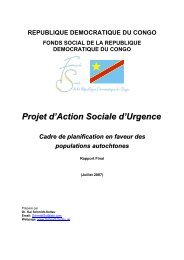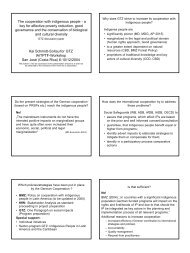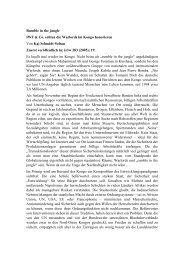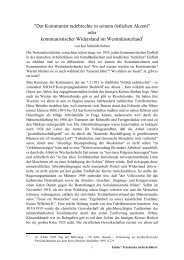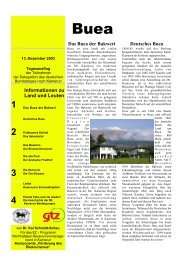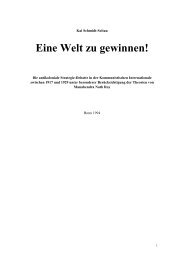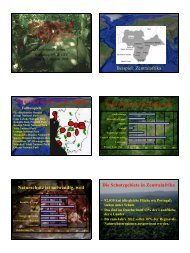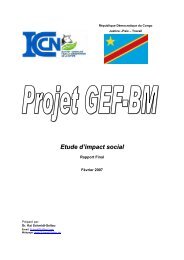View - Dr. Kai Schmidt-Soltau
View - Dr. Kai Schmidt-Soltau
View - Dr. Kai Schmidt-Soltau
Create successful ePaper yourself
Turn your PDF publications into a flip-book with our unique Google optimized e-Paper software.
Oryx Vol 38 No 2 April 2004<br />
Forum<br />
The social and environmental impacts of wilderness and development<br />
Dan Brockington and <strong>Kai</strong> <strong>Schmidt</strong>-<strong>Soltau</strong><br />
Sanderson & Redford’s (2003) correct insistence that<br />
poverty alleviation programmes ought more actively<br />
to include conservation would be well matched by an<br />
awareness of the impacts of some conservation policies,<br />
particularly the establishment of strictly protected areas,<br />
on local livelihoods. Lands protected as wilderness<br />
require the removal or exclusion of people and are<br />
locally costly. Wilderness protection requires, we argue,<br />
far more awareness of the nature and extent of these costs<br />
wherever conservation interests have to be best served<br />
by people’s absence.<br />
Poverty alleviation that overlooks conservation is<br />
not sustainable and will offer no relief to threats to<br />
biodiversity. For several years now biological scientists<br />
and conservationists have reminded us that Millennium<br />
Development Goals, poverty reduction strategies and<br />
the latest trends in sustainable development have to pay<br />
due regard to conservation priorities. Failure to strike<br />
the right balance between conservation and development<br />
is dangerous to conservation, and quite possibly<br />
deleterious to human development.<br />
The converse is also true: if conservationists get the<br />
balance wrong, with environmental policies ignoring the<br />
impoverishment that they may cause, then the result is<br />
certainly harmful to people and quite possibly damaging<br />
for conservation. This is most clearly apparent with the<br />
social impacts of strictly protected areas (IUCN categories<br />
I and II). The international conservation community<br />
at the World Parks Congress has voiced in the Durban<br />
Accord the concern ‘that many costs of protected areas<br />
are born locally – particular by poor communities – while<br />
the benefits accrue globally’ (WPC, 2003: 2). The Congress<br />
made the commitment, ‘that protected area management<br />
strives to reduce, and in no way exacerbates,<br />
poverty’ (WPC, 2003).<br />
Since the inception of national parks, the protection of<br />
perceived wildernesses has necessitated the removal of<br />
people. Some more recent parks have involved careful<br />
compensation arrangements for people evicted, but these<br />
are not the norm. More often, evictions occasion expense,<br />
Dan Brockington (Corresponding author) School of Geography and the<br />
Environment, University of Oxford, Mansfield Rd, Oxford, OX1 3TB, UK.<br />
E-mail dan.brockington@geography.oxford.ac.uk<br />
<strong>Kai</strong> <strong>Schmidt</strong>-<strong>Soltau</strong> P.O. Box 7414, Yaoundé, Cameroon<br />
Received 20 January 2004. Accepted 9 February 2004.<br />
hardship and impoverishment. Assessments of biodiversity<br />
conservation in the context of poverty alleviation<br />
suggest that protected areas do not reduce poverty,<br />
but on the contrary increase the poverty of rural populations<br />
(Brockington, 2002, Cernea & <strong>Schmidt</strong>-<strong>Soltau</strong>,<br />
2003). Compensation for the impoverishment caused<br />
by protected areas requires knowledge of who has<br />
been affected and how greatly their lives have changed.<br />
Appreciation of the multiple benefits of conservation for<br />
biodiversity and for people will be incomplete without<br />
a good understanding of the costs involved.<br />
In our view, wilderness and protected area policies<br />
require a far greater understanding of their social and<br />
environmental impacts, for five reasons. Firstly, there is a<br />
widespread recognition that protected areas that cause<br />
harm or inconvenience to local groups will be threatened<br />
by non-cooperation or outright resistance. State authorities<br />
and conservation organizations are striving to find<br />
ways in which protected areas can provide real benefits<br />
to local groups. They are handicapped by want of<br />
measurement and understanding of the costs involved. It<br />
is therefore hard to tell whether the benefits offered do<br />
provide adequate compensation for the inconvenience<br />
conservation can cause. Similarly, engagement between<br />
conservation authorities and local communities is often<br />
handicapped by inadequate grasp of the history of interaction<br />
and conflict between the two. This has to be recognized<br />
as part of any process of rapprochement. To find a<br />
balance between local people’s needs and protected areas<br />
requires careful and detailed data collection.<br />
Secondly, addressing the costs of conservation is<br />
important for more than just the pragmatic reasons<br />
that not doing so may harm conservation. There may be<br />
instances where it will be possible for conservation policies<br />
to disadvantage local people without compromising<br />
their own objectives. Rural groups may be too weak<br />
effectively to resist and obstruct conservation (Brockington,<br />
2003). But there are powerful ethical reasons why<br />
the power of conservation policies should not be wielded<br />
in this way, in the same way as the power of the poverty<br />
reduction paradigm should not ignore the needs of<br />
biodiversity protection.<br />
Thirdly, conservation can and should be a powerful<br />
tool for wealth creation and poverty reduction. The<br />
potential for conservation agendas to empower and<br />
enrich local groups is recognized in many quarters.<br />
Protected areas in particular can have many positive<br />
© 2004 FFI, Oryx, 38(2), 1–3 DOI: 10.1017/S0030605304000000 Printed in the United Kingdom<br />
1
2 D. Brockington and K. <strong>Schmidt</strong>-<strong>Soltau</strong><br />
benefits for local groups, including provision of ecosystem<br />
services, employment opportunities, and preservation<br />
of cultures. Yet the full impact of these schemes<br />
requires a good understanding of their impacts on<br />
local peoples’ livelihoods and of the opportunity costs<br />
incurred by setting aside land for conservation. The local<br />
politics and distribution of the costs and benefits within<br />
communities must also be understood if the contribution<br />
of these schemes to the common good is to be realized.<br />
Fourthly, the abuses that some groups have suffered as<br />
a result of conservation policy has given human rights<br />
and cultural survival organizations considerable cause<br />
for concern. At the same time it is clear that many of<br />
the data they cite and examples they list are contested<br />
by their opponents. Debates tend to generate more heat<br />
than light and are often characterized by want of good<br />
data. Clearer arguments would be facilitated by better<br />
information.<br />
Fifthly, despite the gains made for protected areas in<br />
recent years there are still biodiversity hotspots and areas<br />
of important habitat that are not adequately protected.<br />
National governments and international conservation<br />
organizations are seeking to expand the area of conservation<br />
estate to meet these needs. To be undertaken properly<br />
this will have to involve good assessments of the<br />
costs that these moves are likely to incur, and the benefits<br />
that they will bring.<br />
But despite these imperatives and their increasing<br />
recognition within conservation, progress in dealing<br />
with them is painfully slow. They still arouse considerable<br />
resistance. Attributing the outputs of the World<br />
Parks Congress, for example, to the ‘international conservation<br />
community’ ignores the marked divisions in the<br />
conference between those who found these measures<br />
important and those who felt they were detracting from<br />
the proper business of conservation. This is particularly<br />
noticeable in the fact that despite a threefold increase in<br />
the number of protected areas in the last 30 years we have<br />
relatively little idea of what the social costs of that expansion<br />
has been. Here conservation is lamentably behind<br />
other fields. The consequences of land loss to dams or<br />
large scale development projects, for example, is now<br />
better recognized, and clear methodologies have been<br />
drawn up to assess the impacts (Cernea & Guggenheim,<br />
1996; Cerna, 1997; Mahapatra, 1999; WCD, 2001; Downing,<br />
2002; World Bank 2002; Cernea, 2000).<br />
The welcome gains made for protected areas in the last<br />
generation have been accompanied by silence over its<br />
social costs (Chatty & Colchester, 2002). This is particularly<br />
worrying where we can expect the eviction of<br />
people to be harmful to livelihoods. In the developing<br />
world many areas worthy of protection are also the<br />
home of predominantly poor rural populations. In these<br />
circumstances we should expect that eviction without<br />
provision for better livelihoods or employment will<br />
cause impoverishment.<br />
It must be remembered that the categories of protected<br />
areas counted in the recent expansion include many<br />
places where human residence is still allowed. The area<br />
occupied by IUCN protected area categories I and II is<br />
only 30% of total protected lands. But a significant proportion<br />
of protected areas are yet to be categorized, and<br />
some of those in categories other than I and II have<br />
required the eviction and exclusion of people (Game<br />
Reserves in Tanzania, for example, which are category<br />
IV) or embody other significant negative impacts for<br />
the inhabitants of these areas (<strong>Schmidt</strong>-<strong>Soltau</strong>, 2004). The<br />
increase in protected areas over recent decades is likely<br />
to have had a considerable human cost, about which<br />
there is remarkable silence or denial in conservation<br />
circles.<br />
In this context it is therefore disappointing that<br />
Sanderson & Redford did not mention this aspect of the<br />
relationship between poverty and conservation, and it<br />
points perhaps to a deeper malaise at work. The fundamental<br />
conflict here might be cognitive (Adams et al,<br />
2003). It is in the framing and awareness of the issues that<br />
problems of conservation-induced impoverishment are<br />
ignored, just as development planners and poverty alleviation<br />
strategies are turning a blind eye to conservation<br />
needs.<br />
Recognizing the existence of both problems does not<br />
mean that both conservation and poverty alleviation can<br />
be equally provided for in any given situation. There are<br />
many cases where conservation can only proceed in the<br />
absence of people and removing them will be costly and<br />
violent. Nor will economic measures alone capture the<br />
full loss of identity, home, belonging and the other intangibles<br />
that protected areas will deny. Equally, development<br />
and the spread of human influence has had, and<br />
will continue to have, a devastating impact on habitat<br />
and species survival. Recognizing the existence of both<br />
needs will require recognizing conflicts and incompatibilities.<br />
Development that is sensitive to conservation needs<br />
will, as Redford & Sanderson recognize, be sensitive to<br />
local needs and the diversity of local priorities, and will<br />
prioritize livelihood change that leaves space for Nature.<br />
But it will still, on occasion, be destructive. Prioritizing<br />
conservation needs in development will not mean ceasing<br />
to transform the world, but understanding precisely<br />
what the losses to biodiversity and conservation will be.<br />
Then it will be possible to know what sort of redress is<br />
necessary, and which losses cannot be compensated for.<br />
Equally, strict protected areas that are pro-poor will not<br />
necessarily mean no more evictions. But they will be<br />
© 2004 FFI, Oryx, 38(2), 1–3
Wilderness and development<br />
3<br />
aware of the costs of these moves. They will actively seek<br />
to assess the full economic, cultural and psychological<br />
impacts, and they will strive to adequately compensate<br />
any losses and mitigate the damage.<br />
Practically, we can suggest two specific priorities<br />
necessary for conservation to achieve such sensitivity.<br />
Firstly, in recognition of the power and influence<br />
wielded by international conservation organizations it<br />
will be important for them to develop codes of conduct<br />
with respect to the social impacts of the policies they<br />
support. These are analogous to the conservation codes<br />
of conduct advocated for private companies (Sanderson,<br />
2002). These codes could, following the poverty reduction<br />
recommendation of the World Parks Congress,<br />
involve commitments not to support conservation policies<br />
that perpetrate injustices or that, for example, entail<br />
evictions without adequate compensation.<br />
Secondly, it is imperative to have some sort of assessment<br />
of the nature of the social impact of protected areas,<br />
especially given recent expansions. This requires a substantial<br />
effort, but is easily within current capacities. We<br />
have developed a methodology for such a global assessment<br />
(<strong>Schmidt</strong>-<strong>Soltau</strong> & Brockington, 2004), based on<br />
a sample of 196 protected areas (2% of IUCN protected<br />
area categories I and II) that will examine the consequences<br />
of land loss, and the benefits of protected<br />
areas, based on our previous work (Brockington, 2002;<br />
<strong>Schmidt</strong>-<strong>Soltau</strong>, 2003). Its success depends on the widespread<br />
involvement of diverse regional experts, and<br />
we would welcome comments, advice and involvement.<br />
We hope it will be a means to actively address the<br />
impoverishment that conservation can cause.<br />
Sustainability has both ecological and social dimensions.<br />
Population relocation for park creation requires<br />
this double sustainability – of livelihoods and of the<br />
biosphere. When protected area policies and resources<br />
are put in place to ensure poverty reduction through<br />
relocation for park creation, than the double sustainability<br />
would be accomplished. This is possible but<br />
relatively expensive. Estimates for such resettlement in<br />
rain forest are $20–30 thousand per person (Cernea &<br />
<strong>Schmidt</strong>-<strong>Soltau</strong>, 2003). Where the political will to achieve<br />
double sustainability is not available the rural population<br />
will lose and biodiversity conservation is unlikely to<br />
win local support. We agree with Sanderson & Redford<br />
‘that the single requirement is a dedication to create . . .<br />
partnerships between conservationists and developmentalists’,<br />
but we insist that a reconciliation that ignores<br />
either the social or ecological costs will lead nowhere.<br />
References<br />
Adams, W.A., Brockington, D. Dyson, J. & Vira, B. (2003)<br />
Managing tragedies. Understanding conflict over common<br />
pool resources. Science 302, 1915–6.<br />
Brockington, D. (2002) Fortress Conservation. The Preservation of<br />
the Mkomazi Game Reserve, Tanzania, James Currey, Oxford,<br />
UK.<br />
Brockington, D. (2003) Injustice and conservation – Is ‘local<br />
support’ necessary for sustainable protected areas?’ Policy<br />
Matters, 12, 22–30.<br />
Cernea, M.M. (1997) The risks and reconstruction model for<br />
resettling displaced populations. World Development, 25,<br />
1569–1589.<br />
Cernea, M.M. (2000) Risk, safeguards and reconstruction: a<br />
model for population displacement and resettlement. In Risk<br />
and Reconstruction: Experiences of Resettlers and Refugees (eds<br />
M.M. Cernea & C. McDowell), pp. XX–XX. Word Bank,<br />
Washington, DC, USA.<br />
Cernea, M.M. & Guggenheim, S. (1996) Resettlement and<br />
Development. The Bankwide Review of Projects Involving<br />
Involuntary Resettlement. ESSD, Resettlement Series no.<br />
32,World Bank, Washington, DC, USA.<br />
Cernea, M.M. & <strong>Schmidt</strong>-<strong>Soltau</strong>, K. (2003) National Parks and<br />
Poverty Risks: Is Population Resettlement the Solution? Paper<br />
presented at the World Park Congress (Durban, September<br />
2003). An abbreviated version was published as: The end of<br />
forced resettlements for conservation: Conservation must not<br />
impoverish people, Policy Matters, 12, 42–51.<br />
Chatty, D. & Colchester, M. (2002) Conservation and Mobile<br />
Indigenous Peoples: Displacement, Forced Settlement and<br />
Sustainable Development. Berghahn, Oxford, UK.<br />
Downing, T.E. (2002) Avoiding New Poverty: Mining-Induced<br />
Displacement and Resettlement. International Institute for<br />
Environment and Development and World Business Council<br />
for Sustainable Development, City, Country.<br />
Mahapatra, L.K. (1999) Resettlement, Impoverishment and<br />
Reconstruction in India: Development for the Deprived. Vikas<br />
Publishing House, New Delhi, India.<br />
Sanderson, S.E. (2002) The Future of Conservation. Foreign<br />
Affairs, 81, 162–173.<br />
Sanderson, S.E. & Redford, K. ( 2003) Contested relationships<br />
between biodiversity conservation and poverty alleviation.<br />
Oryx, 37, 389–390.<br />
<strong>Schmidt</strong>-<strong>Soltau</strong>, K. (2003) Conservation-related resettlement in<br />
Central Africa: environmental and social risks. Development<br />
and Change, 34, 525–551.<br />
<strong>Schmidt</strong>-<strong>Soltau</strong>, K. (2004) The local costs of rainforest<br />
conservation: local responses towards integrated<br />
conservation and development projects. Journal of<br />
Contemporary African Studies (in press).<br />
<strong>Schmidt</strong>-<strong>Soltau</strong>, K. & Brockington, D. (2004) The Social<br />
Impacts of Protected Areas.<br />
Http://www.social-impact-of-conservation.net<br />
[accessed 12 February 2004].<br />
WCD (2001) Dams and Development: A New Framework for<br />
Decision Making. Earthscan, London, UK.<br />
World Bank (2002) Operational Policy 4.12: Involuntary<br />
Resettlement. World Bank, Washington, DC, USA.<br />
WPC (World Park Congress) (2003) List of Recommendations<br />
approved at the World Parks Congress.<br />
Http://www.iucn.org/themes/wcpa/wpc2003/english/<br />
outputs/recommendations.htm [accessed 11 February 2004].<br />
1<br />
2<br />
© 2004 FFI, Oryx, 38(2), 1–3




